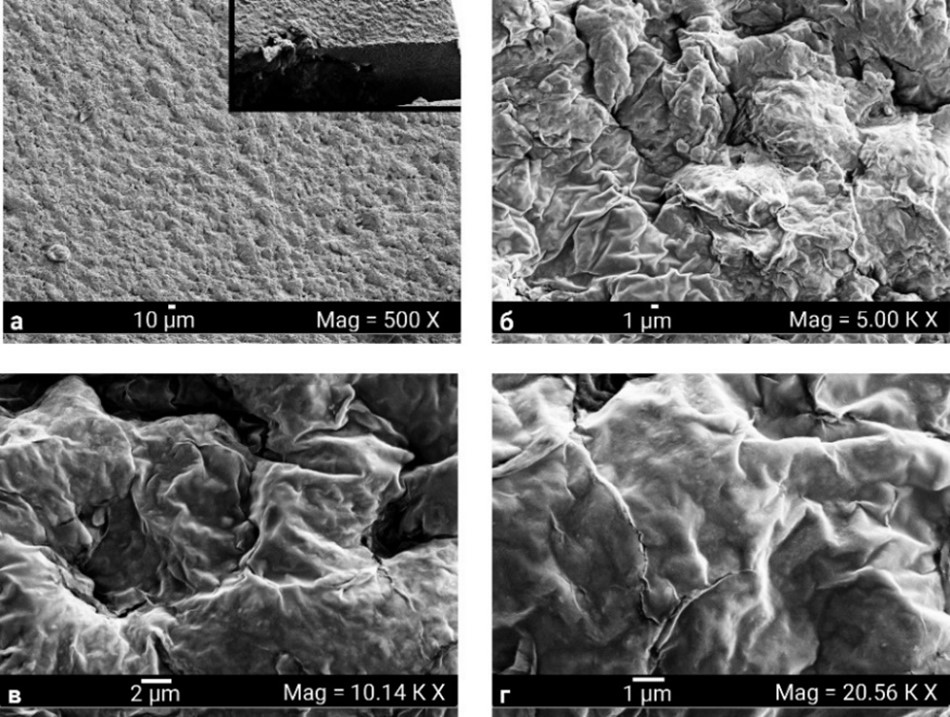IN SITU SYNTHESIS AND STUDY OF TWO-PHASE HYBRID HYDROGELS OF β-CYCLODEXTRIN/CELLULOSE BY SCANNING ELECTRON MICROSCOPY AND FTIR SPECTROSCOPY
UDC 547.458.81:54.056
Abstract
Two-phase hybrid hydrogels from powder cellulose (PC) and/or microcrystalline cellulose (MCC) and biologically active natural cyclic oligosaccharide β-cyclodextrin (β-CD) were obtained by combining them in the solvent N,N-dimethylacetamide/LiCl and regenerating the hydrogels from the solutions. Cellulose-cyclodextrin hybrid hydrogels were synthesized for the first time without use of cross-agents and/or other gel-promoting components, and without precipitants and anti-solvents under atmospheric conditions. The properties of the composites depended on the type of pristine cellulose and the method of combining the components. Optimally, composite hydrogels were obtained by combining a 1–3 wt.% solution of PC in DMAA/LiCl followed by the addition of β-CD powder to the solution. The water-retention capacity of MCC/β-CD hydrogel was 48.8 g g-1, that of deciduous and flax PC/β-CD hydrogels 62.9 and 55.5 g g-1 respectively. The morphology of the hybrid gels was characterized by scanning electron microscopy (SEM) and the functional content was determined by Fourier transform IR spectroscopy. It was shown that the hydrogels seem to be two-phase interpenetrating systems that interact at the interface. Both phases coexist as a monolithic agglomerate stabilized additionally by hydrogen bonds. Each phase has an individual shape and morphological structure. The results allow the use of cellulose-containing materials, including waste materials, in the elaboration of new hybrid materials to be predicted.
Downloads
Metrics
References
Kotel'nikova N.Ye. Adsorbtsionno-khimicheskaya modifikatsiya tsellyulozy biologicheski aktivnymi veshchestvami: dis... dokt. khim. nauk. [Adsorption-chemical modification of cellulose with biologically active substances: dis... doc. chem. Sci.]. St. Petersburg, 2001, 303 p. (in Russ.).
Cellulose composites: processing and characterization, ed. P.K. Rakesh, J.P. Davim. Berlin; Boston, 2023, 181 p. DOI: 10.1515/9783110768787.
Cellulose and cellulose composites: modification, characterization and applications, ed. M.I.H. Mondal. New York, 2015, 579 p.
Hubbe M.A., Rojas O.J., Lucia L.A., Sain M. BioResources, 2008, vol. 3, pp. 929–980. DOI: 10.15376/biores.3.3.929-980.
Freire C.S., Silvestre A.J., Gandini A., Neto C.P. O PAPEL, 2011, vol. 72, pp. 91–96.
Wicklein B., Salazar-Alvarez G. Journal of materials chemistry A, 2013, vol. 1, pp. 5469–5478. DOI: 10.1039/c3ta01690k.
Duan J., Zhang X., Jiang J., Han C., Yang J. et al. Journal of nanomaterials, 2014, pp. 1–7. DOI: 10.1155/2014/312696.
Kapustin M.A., Chubarova A.S., Golovach T.N., Tsygankov V.G., Bondarchuk A.M., Kurchenko V.P. Trudy BGU, 2016, no. 11, pp. 73–100. (in Russ.).
Dodziuk H. Cyclodextrins and their complexes: chemistry, analytical methods, applications. Wheinheim, 2006.
Novosolova N.V. Osobennosti povedeniya β-tsiklodekstrinov v vodnykh rastvorakh i ikh vzaimodeystviye s vi-taminami i poverkhnostno-aktivnymi veshchestvami: avtoref. dis. ... kand. khim. nauk. [Features of the behavior of β-cyclodextrins in aqueous solutions and their interaction with vitamins and surfactants: abstract of thesis. dis. ...cand. chem. Sci.]. Moscow, 2005, 155 p. (in Russ.).
Kedik S.A., Panov A.V., Tyukova V.S., Zolotareva M.S. Razrabotka i registratsiya lekarstvennykh sredstv, 2016, no. 3, pp. 68–75. (in Russ.).
Yu Y., Li J., Sun Y., Liang Q., Peng X. et al. Petroleum Science, 2008, vol. 5, pp. 263–268. DOI: 10.1007/s12182-008-0044-y.
Shipilov D.A. Novyye proizvodnyye β-tsiklodekstrina kak potentsial'nyye nositeli lekarstvennykh sredstv. Osobennosti sinteza i farmakologicheskogo deystviya: diss. ... kand. khim. nauk. [New β-cyclodextrin derivatives as potential drug carriers. Features of synthesis and pharmacological action: dissertation. ...cand. chem. Sci.]. Moscow, 2018. (in Russ.).
Uekama K., Hirayama F., Irie T. Chem. Rev., 1998, vol. 98, pp. 2045–2076. DOI: 10.1021/cr970025p.
Oliveira V. da S., Silva C.C., de Freitas Oliveira J.W., da Silva M. de S., Ferreira P.G. et al. Journal of Drug Delivery Science and Technology, 2023, vol. 81, 104229. DOI: 10.1016/j.jddst.2023.104229.
Naeem A., Yu C., Zang Z., Zhu W., Deng X., Guan Y. Antioxidants, 2023, vol. 12, 552. DOI: 10.3390/antiox12030552.
Zhang F., Wu W., Sharma S., Tong G., Deng Y. BioResources, 2015, vol. 10, pp. 7555–7568. DOI: 10.15376/biores.10.4.7555-7568.
Crini G. Dyes and Pigments, 2008, vol. 77, pp. 415–426. DOI: 10.1016/j.dyepig.2007.07.001.
Ghemati D., Aliouche D. MSF, 2009, vol. 609, pp. 287–291. DOI: 10.4028/www.scientific.net/MSF.609.287.
Cova T.F., Murtinho D., Pais A.A.C.C., Valente A.J.M. Frontiers in Chemistry, 2018, vol. 6. DOI: 10.3389/fchem.2018.00271.
Desmet G. Functionalization of cotton-cellulose via high energy irradiation initiated grafting and cyclodextrin immobi-lization: master’s thesis. Budapest, Hungary, 2010.
Jia H., Schmitz D., Ott A., Pich A., Lu Y. Journal of materials chemistry A, 2015, vol. 3, pp. 6187–6195. DOI: 10.1039/c5ta00197h.
Medronho B., Duarte H., Alves L., Antunes F.E., Romano A., Valente A.J.M. Carbohydrate Polymers, 2016, vol. 140, pp. 136–143. DOI: 10.1016/j.carbpol.2015.12.026.
Del Valle L.J., Díaz A., Puiggalí J. Gels, 2017, vol. 3, 27. DOI: 10.3390/gels3030027.
Gurarslan A., Joijode A., Shen J., Narayanan G., Antony G.J. et al. Polymers, 2017, vol. 9, 673. DOI: 10.3390/polym9120673.
Zhang L., Zhou J., Zhang L. Carbohydrate Polymers, 2013, vol. 94, pp. 386–393. DOI: 10.1016/j.carbpol.2012.12.077.
Kotel'nikova N.Ye., Mikhailidi A.M., Martakova Yu.V. Vysokomolekulyarnyye soyedineniya (seriya A), 2017, vol. 59, pp. 76–87. DOI: 10.7868/s2308112017010084. (in Russ.).
Shcherbakova T.P., Kotel'nikova N.Ye., Bykhovtsova Yu.V. Khimiya rastitel'nogo syr'ya, 2012, no. 2, pp. 5–14. (in Russ.).
Mikhailidi A., Kotelnikova N., Riabov S., Saprikina N., Vlasova E. Sbornik mat. VI Mezhdunar. konf. «Fizikokhimiya rastitel'nykh polimerov». [Collection of mats. VI Int. conf. "Physicochemistry of plant polymers"]. Arkhangel'sk, 2015, pp. 238–241.
Fengel D., Wegener G. Wood: Chemistry, Ultrastructure, Reactions. Berlin; New York, 2011, 626 p.
Aleshina L.A., Glazkova S.V., Lugovskaya L.A., Podoynikova M.V., Fofanov A.D., Silina Ye.V. Khimiya ras-titel'nogo syr'ya, 2001, no. 1, pp. 5–36. (in Russ.).
Chatjigakis A.K., Donze C., Coleman A.W., Cardot P. Anal. Chem., 1992, vol. 64, pp. 1632–1634. DOI: 10.1021/ac00038a022.
Rachmawati H., Edityaningrum C.A., Mauludin R. AAPS PharmSciTech, 2013, vol. 14, pp. 1303–1312. DOI: 10.1208/s12249-013-0023-5.
Bratu I., Hernanz A., Gavira J.M., Bora G. Romanian journal of physics, 2005, vol. 50, pp. 1063–1069.
Fengel D. Holzforschung, 1992, vol. 46, pp. 283–288. DOI: 10.1515/hfsg.1992.46.4.283.

Copyright (c) 2023 chemistry of plant raw material

This work is licensed under a Creative Commons Attribution 4.0 International License.

This work is licensed under a Creative Commons Attribution 4.0 International License.
The authors, which are published in this journal, agree to the following conditions:
1. Authors retain the copyright to the work and transfer to the journal the right of the first publication along with the work, at the same time licensing it under the terms of the Creative Commons Attribution License, which allows others to distribute this work with the obligatory indication of the authorship of this work and a link to the original publication in this journal .
2. The authors retain the right to enter into separate, additional contractual agreements for the non-exclusive distribution of the version of the work published by this journal (for example, to place it in the university depository or to publish it in a book), with reference to the original publication in this journal.
3. Authors are allowed to post their work on the Internet (for example, in a university repository or on their personal website) before and during the review process of this journal, as this may lead to a productive discussion, as well as more links to this published work.











